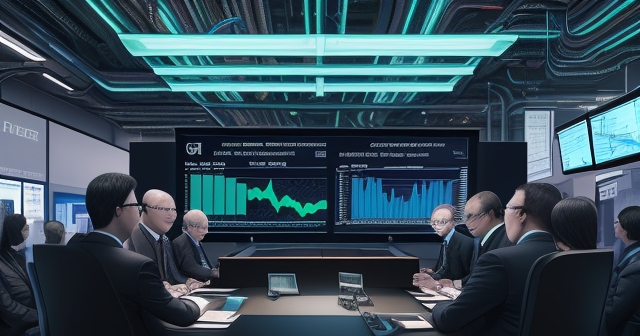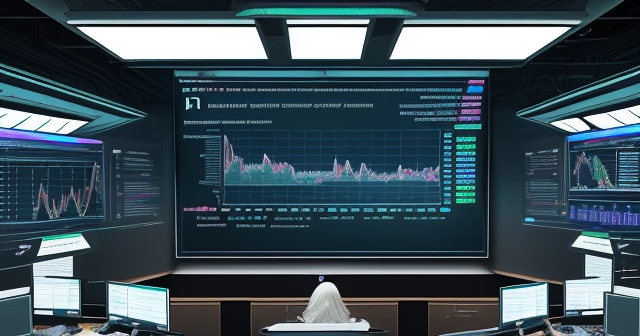Navigating the Semiconductor Landscape: A Deep Dive into AMD’s Q1 2025 Earnings and Future Outlook
Welcome, fellow travelers on the investment journey. Today, we embark on a detailed exploration of Advanced Micro Devices, or AMD, a key player in the dynamic semiconductor industry. We’re not just looking at raw numbers; we’re aiming to understand the forces driving their business, the challenges they face, and what their latest financial report from the first quarter of fiscal year 2025 tells us about their path forward. Think of this as dissecting the engine of a high-performance machine – every part plays a role, and understanding how they work together is key to predicting its trajectory.
For both new investors just starting to grasp financial statements and experienced traders looking to refine their analysis, understanding earnings reports is fundamental. It’s like reading the pulse of a company. In this deep dive, we will break down AMD’s performance, segment by segment, analyze the impact of external factors like regulatory changes, and peer into their projections for the upcoming quarter. Are you ready to build a more robust understanding?

Before we dissect AMD’s specific performance, let’s ensure we’re all speaking the same language when it comes to financial metrics. When companies report earnings, you’ll often see figures presented in two ways: GAAP and Non-GAAP. What’s the difference, and why does it matter?
GAAP stands for Generally Accepted Accounting Principles. These are standardized rules and guidelines for financial reporting in the United States. GAAP figures provide a comprehensive view of a company’s financial health, including all revenues and expenses, even those that might be non-cash or non-recurring.
Non-GAAP, on the other hand, excludes certain items that management believes are not indicative of the company’s core operational performance. Common exclusions include stock-based compensation, amortization of acquisition-related intangibles, restructuring charges, and other one-time costs. The argument for using Non-GAAP metrics is that they can provide a clearer picture of the company’s underlying business trends and profitability from ongoing operations.
However, it’s crucial to look at both. While Non-GAAP can highlight operational efficiency, GAAP provides a more complete picture. Comparing the two can reveal the impact of these excluded items on overall profitability. For AMD’s Q1 2025, we saw both GAAP and Non-GAAP figures reported, and the differences were significant, particularly in earnings per share (EPS).
Other key metrics we’ll examine include:
- Revenue: The total amount of money generated from the sale of products and services. This is the top line, showing how much business the company did.
- Gross Margin: Revenue minus the cost of goods sold, expressed as a percentage. This tells us how efficiently the company produces its goods and services before accounting for operating expenses. A higher gross margin generally indicates better pricing power or lower production costs.
- Operating Income: Gross profit minus operating expenses (like research and development, sales, marketing, and administrative costs). This shows profitability from the company’s core business operations.
- Earnings Per Share (EPS): Net income divided by the number of outstanding shares. This metric indicates how much profit is allocated to each outstanding share of stock and is a widely followed indicator of corporate profitability.
| Key Metric | Description |
|---|---|
| Revenue | Total money generated from sales |
| Gross Margin | Revenue minus cost of goods sold |
| Operating Income | Profit from core business operations |
| Earnings Per Share (EPS) | Profit allocated to each outstanding share |
Understanding these terms gives us the vocabulary to interpret the numbers AMD presented.
AMD’s Q1 2025 Performance: Exceeding Expectations
Let’s dive into the headline numbers from AMD’s first quarter of 2025. The company reported total revenue of $7.4 billion. This figure represented a substantial increase of 36% year-over-year (Y/Y) compared to the first quarter of 2024. While it was down slightly by 3% quarter-over-quarter (Q/Q) from the preceding fourth quarter of 2024, the strong Y/Y growth is a key indicator of momentum.
Crucially, this revenue figure beat analyst expectations, which were estimated to be in the range of $7.12 billion to $7.13 billion. Exceeding Wall Street’s consensus is often viewed favorably by the market, suggesting the company performed better than anticipated.

Looking at profitability, AMD also delivered strong results. The Non-GAAP gross margin came in at 54%. This was an improvement of 2 percentage points Y/Y and remained flat Q/Q, demonstrating stable and healthy profitability on their core product sales. The GAAP gross margin was 50%, up 3 percentage points Y/Y, showing a similar positive trend even when including all costs.
The earnings per share figures were particularly impressive, showcasing significant leverage on the increased revenue.
- GAAP Diluted EPS: $0.44, a staggering increase of 529% Y/Y. This massive jump reflects improved operational efficiency and potentially lower one-time costs compared to the prior year.
- Non-GAAP Diluted EPS: $0.96, a strong increase of 55% Y/Y. This figure also comfortably beat analyst expectations, which were around $0.93 to $0.94. The significant difference between GAAP and Non-GAAP EPS ($0.44 vs $0.96) highlights the impact of items excluded from the Non-GAAP calculation, such as stock-based compensation and acquisition-related amortization, which are substantial for a company of AMD’s size and strategic activity.
The operating income figures reinforced this picture of improved profitability, with GAAP operating income up a remarkable 2,139% Y/Y and Non-GAAP operating income up 57% Y/Y. These numbers paint a picture of a company executing well and benefiting from strong demand in key areas, translating top-line growth into significant earnings leverage.
The Engine Room: Analyzing Performance by Business Segment
To truly understand AMD’s performance, we must look under the hood and examine the contributions of its various business segments. Companies often structure their reporting this way to provide transparency into which parts of the business are thriving and which might be facing headwinds. AMD’s segments are Data Center, Client, Gaming, and Embedded.
The Powerhouse: Data Center Segment Analysis
Without a doubt, the star of the show in Q1 2025 was the Data Center segment. This segment, which includes processors and accelerators for servers and cloud computing, delivered revenue of $3.7 billion. This represented a phenomenal 57% year-over-year increase. This growth wasn’t accidental; it was primarily fueled by strong demand for AMD’s flagship products in this space:
- AMD EPYC™ CPUs: These server processors are direct competitors to Intel’s Xeon line and have been steadily gaining market share in recent years. Strong demand here indicates continued adoption by large enterprises and cloud service providers building out their infrastructure.
- AMD Instinct™ GPUs: These graphics processing units are designed specifically for high-performance computing (HPC) and, crucially, Artificial Intelligence (AI) workloads. The surge in AI development and deployment has created unprecedented demand for specialized chips capable of training and running complex AI models. AMD’s Instinct MI300 series is a direct competitor to Nvidia’s dominant AI accelerators, and strong sales here highlight AMD’s growing presence in this critical market.
The fact that the Data Center segment alone generated $3.7 billion, nearly half of the total revenue, and grew at such a rapid clip underscores its importance as AMD’s primary growth engine. The demand environment for AI and cloud infrastructure remains incredibly robust, and AMD appears well-positioned to capitalize on this trend with its EPYC and Instinct product lines.
Client and Gaming Segments: A Mixed Picture
Next, let’s look at the combined Client and Gaming segment, which generated $2.9 billion in revenue, up 28% Y/Y overall. However, examining the individual components reveals a more nuanced story.
Client Segment: This segment includes processors for desktop and notebook PCs. For several quarters, this market faced challenges due to softening PC demand. However, Q1 2025 showed a significant rebound, with Client revenue hitting $2.3 billion, a substantial 68% year-over-year increase. What drove this impressive turnaround? According to AMD, it was primarily fueled by:
- Strong demand for the latest “Zen 5” AMD Ryzen™ processors: This suggests that AMD’s newest generation of consumer processors is being well-received by the market, likely offering competitive performance and features that are enticing consumers and commercial buyers.
- A richer mix: This often implies a shift towards selling higher-end, more expensive processors, which boosts average selling prices and revenue.
This rebound in the Client segment is a positive development, showing that AMD isn’t solely reliant on the Data Center for growth and can benefit from improvements in the traditional PC market, especially with compelling new products.
Gaming Segment: This segment includes graphics cards for PCs (Radeon) and semi-custom chips for gaming consoles (like PlayStation and Xbox). Unlike the Client segment, Gaming revenue experienced a decline, falling to $647 million, down 30% year-over-year. The primary reason cited for this decrease was a reduction in semi-custom revenue. The console cycle plays a significant role here; as the current generation of consoles matures, demand for the custom chips inside them typically tapers off until the next generation is introduced. While PC graphics card sales (Radeon) also contribute, the semi-custom console business often represents a large portion of this segment’s revenue, making it susceptible to cyclical patterns.
The Embedded Segment: Steady but Soft
Finally, we have the Embedded segment, which includes adaptive SoCs (System-on-Chips) and FPGAs (Field-Programmable Gate Arrays) used in diverse applications like industrial, automotive, aerospace, and communications infrastructure (like 5G). Revenue in this segment was $823 million, a slight decrease of 3% year-over-year. This reflects what AMD described as mixed end-market demand. The Embedded market is highly fragmented, with different industries experiencing varying levels of investment and demand at any given time. The slight decline suggests that while some areas might be growing, others are likely contracting or remaining flat, leading to a modest overall dip for the segment.
| Segment | Revenue | Growth Rate (Y/Y) |
|---|---|---|
| Data Center | $3.7 billion | 57% |
| Client | $2.3 billion | 68% |
| Gaming | $647 million | -30% |
| Embedded | $823 million | -3% |
Looking at the segments together, the picture is clear: explosive growth in the Data Center, a strong rebound in Client, cyclical weakness in Gaming (specifically semi-custom), and relative stability with a slight dip in Embedded. This highlights the importance of a diversified product portfolio, where strength in one area can help offset softness in others, although the Data Center’s performance is clearly the dominant driver of overall growth currently.
Navigating Regulatory Currents: The Impact of Export Controls
While AMD’s Q1 performance was robust and beat expectations, the outlook for the second quarter is significantly impacted by external factors, particularly U.S. export controls. These regulations, aimed at restricting the sale of advanced semiconductor technology to certain entities and regions (most notably, China), are a material consideration for companies operating in the high-tech space.
AMD had previously disclosed that these controls would affect shipments of its Instinct MI308X accelerators to China. In their Q1 report and subsequent guidance, they provided more specific figures on the financial impact of these restrictions.
For the second quarter of 2025, AMD expects to see approximately $700 million in lost revenue directly attributable to these export controls. This is revenue they would otherwise have expected to generate from the sale of affected products but cannot due to the restrictions. Furthermore, they estimated the total lost revenue through the end of their fiscal year from these controls to be around $1.5 billion.
But the impact isn’t just on the top line (revenue). These restrictions also have implications for inventory. AMD disclosed that their Q2 2025 outlook includes approximately $800 million in charges for inventory and related reserves due to the new export controls. What does this mean?
- Inventory: When products are manufactured but cannot be sold due to unforeseen restrictions, they become excess inventory.
- Reserves/Charges: Accounting principles require companies to recognize potential losses. If inventory is unlikely to be sold (or sold at a significantly reduced price) because of export restrictions, the company must take a charge against earnings to reflect the reduced value or potential loss associated with that inventory.

This $800 million charge is a direct consequence of manufacturing chips like the MI308X that were intended for markets now subject to strict export controls. It hits the company’s profitability, specifically impacting the gross margin.
This is why understanding external factors is crucial for investors. Government regulations, trade policies, and geopolitical tensions can have a direct and material impact on a company’s financials, even if their underlying technology and market demand are strong in other areas. AMD’s situation with the MI308X and China exports is a clear example of this.
Looking Ahead: AMD’s Q2 2025 Outlook and Expectations
Based on their Q1 performance and their assessment of the current market environment, including the impact of the export controls, AMD provided guidance for the second quarter of 2025. They expect revenue to be approximately $7.4 billion, plus or minus $300 million. This outlook was somewhat below where some Wall Street estimates stood prior to the full disclosure of the export control impact.
The gross margin outlook for Q2 2025 is particularly notable due to the export control charge. AMD guided for a Non-GAAP gross margin of 43%. However, this figure is *inclusive* of the approximately $800 million charge for inventory and related reserves we just discussed. If you were to *exclude* this one-time charge, the underlying Non-GAAP gross margin would be significantly higher, estimated to be approximately 54% – flat with the Q1 Non-GAAP margin. This clearly illustrates the direct financial impact of the export controls on near-term profitability.
This guidance presents a picture of continued strong underlying business performance, particularly in the Data Center and Client segments, but with a significant, quantifiable headwind from the export restrictions in Q2. The revenue outlook being flat Q/Q (around $7.4 billion for both Q1 reported and Q2 guidance) might seem modest compared to the Y/Y growth, but it reflects the absorption of the $700 million in lost revenue due to controls while other parts of the business continue to grow.
For investors, the key takeaway from the Q2 outlook is to differentiate between the operational performance (represented by the underlying 54% gross margin ex-charge and continued segment growth) and the impact of the external regulatory environment. It’s a reminder that even companies operating at the forefront of technology are subject to broader geopolitical and policy shifts.
Strategic Initiatives and Product Portfolio Positioning
Beyond the quarterly numbers and near-term outlook, AMD continues to execute on its strategic vision, which involves expanding its product portfolio and forging key partnerships to capitalize on future market opportunities, particularly in AI and high-performance computing. These strategic moves underscore the company’s commitment to long-term growth despite navigating dynamic market conditions and regulatory headwinds.
One notable strategic highlight mentioned was the closing of the acquisition of ZT Systems. ZT Systems is a leading provider of custom server and storage solutions optimized for hyperscale cloud and enterprise data centers. This acquisition is significant because it enhances AMD’s ability to deliver integrated solutions directly to large customers, particularly those building out massive AI infrastructure. It moves AMD higher up the value chain, potentially improving relationships with hyperscalers (like Google, Oracle, and others mentioned in the data) and enabling deeper collaboration on server design and deployment tailored for AMD’s EPYC and Instinct products. This is a direct response to the growing demand for optimized systems in the Data Center.

AMD is also actively expanding its partnerships across the AI ecosystem. The data highlighted collaborations with major players, including:
- Hyperscalers: Deployments with Oracle and Google Cloud leveraging AMD’s products for their infrastructure.
- AI Model Developers: Partnerships with entities like Meta (Llama 4), Google (Gemma 3), and DeepSeek-R1 to optimize their leading AI models to run efficiently on AMD Instinct accelerators using AMD’s ROCm™ software platform. This is crucial for driving adoption and demonstrating the performance capabilities of AMD’s AI hardware.
- Telecom and Enterprise: Collaborations with Core42/G42, Dell, CEA France, Jio, Cisco, and Nokia on initiatives like the Open Telecom AI Platform and using AMD’s products in enterprise and network infrastructure. These partnerships broaden AMD’s reach beyond traditional data centers into emerging areas like edge computing and private AI deployments.
- Industry Standards: Support for specifications like UALink 1.0, an industry standard for connecting accelerators, which promotes interoperability and strengthens the broader AI hardware ecosystem.
These partnerships demonstrate AMD’s commitment to building a comprehensive AI ecosystem around its hardware, recognizing that performance isn’t just about the chip itself but also the software, system integration, and industry collaboration that surrounds it. This strategic focus is vital for competing effectively in the intense AI market, particularly against dominant players.
Furthermore, AMD continues to refresh and introduce new products across its portfolio. Recent launches highlighted in the data included new Radeon graphics cards, the latest Ryzen 9000 series processors (potentially featuring 3D V-Cache technology for enhanced gaming performance), EPYC Embedded processors, and Versal/Virtex adaptive SoCs for various embedded and networking applications. A consistent cadence of new, competitive products is essential for maintaining market relevance and driving future revenue growth across all segments.
Executive Insights: Leadership Perspectives
What do the leaders at AMD say about these results and the path ahead? Executive commentary often provides valuable insights into management’s perspective on performance, strategy, and challenges.
Dr. Lisa Su, AMD’s Chair and CEO, provided a clear message. She highlighted the “outstanding start to 2025” and emphasized that year-over-year growth accelerated for the fourth consecutive quarter, driven by strength in core businesses and expanding data center and AI momentum. This reinforces the narrative that the company is on a strong growth trajectory, powered by secular trends in AI and HPC.
Dr. Su also addressed the external environment directly, stating, “Despite the dynamic macro and regulatory environment, our first quarter results and second quarter outlook highlight the strength of our differentiated product portfolio and consistent execution positioning us well for strong growth in 2025.” This suggests confidence that while headwinds like export controls exist, AMD’s fundamental technology and operational execution are robust enough to continue driving overall growth throughout the year. The reference to a “differentiated product portfolio” points to products like the Instinct MI300 series and the latest EPYC/Ryzen processors as key competitive advantages.

Jean Hu, AMD’s CFO, focused on the financial execution. She emphasized the “36% year-over-year revenue growth and significant earnings leverage” as proof of effective financial management. Her comments also noted the company’s continued investment in R&D and go-to-market strategies, indicating that AMD is allocating resources to fuel future innovation and sales efforts, which is crucial for sustaining long-term growth.
Executive commentary provides a layer of qualitative data that complements the quantitative figures. It helps us understand management’s priorities, their assessment of the market and competitive landscape, and their level of confidence in the company’s strategy. In this case, the commentary projects confidence in the underlying business strength while acknowledging the challenges posed by the regulatory environment.
Competitive Landscape and Market Positioning
Understanding AMD’s performance requires placing it within the broader context of the semiconductor market, particularly relative to its key competitors. While the data primarily focuses on AMD’s own results, it implicitly highlights its position in fiercely contested markets.
In the server CPU market, AMD is the primary challenger to Intel. The data mentions that AMD is the “second-place server central processing unit vendor, behind Intel,” and that its EPYC line has been “taking market share in recent years.” The continued strong growth in AMD’s Data Center CPU sales ($3.7B in Q1, up 57% Y/Y in a segment heavily featuring EPYC) suggests this trend of market share gains against Intel may be continuing. This is a critical battleground, as server CPUs are high-value components powering the cloud and enterprise data centers.
In the high-performance GPU and AI accelerator market, AMD is positioned as the closest competitor to Nvidia. The data refers to AMD being the “closest competitor to Nvidia for ‘big GPUs’,” mentioning that AMD did “$5 billion in AI GPU sales in the company’s fiscal 2024.” While this $5 billion figure is from the prior fiscal year, the strong Q1 2025 Data Center growth (driven partly by Instinct GPU sales) indicates continued momentum in this area. Nvidia currently holds a dominant position in the AI accelerator market, so AMD’s growth here is a significant step towards offering a credible alternative and capturing a portion of this rapidly expanding market. The partnerships with hyperscalers and AI model developers are key strategies for AMD to gain traction and compete effectively against Nvidia’s established ecosystem.
In the Client (PC CPU) market, AMD also competes directly with Intel. The strong 68% Y/Y growth in AMD’s Client revenue, driven by Zen 5 Ryzen processors, suggests AMD is performing very well in this segment currently, potentially taking share or benefiting from a general PC market rebound more effectively than competitors in Q1.
Understanding this competitive dynamic is essential. AMD’s growth in Data Center CPUs and AI GPUs isn’t happening in a vacuum; it represents shifts in customer preference and market share in key areas dominated by large, established players. Their strategic moves, product launches, and partnerships are all aimed at strengthening their competitive position and capturing more of the overall semiconductor market value.
What Does This Mean for Investors? Connecting the Dots
So, what can we as investors and traders glean from this detailed analysis of AMD’s Q1 2025 earnings report and Q2 outlook? It’s about connecting the individual data points to form a broader picture and understanding the implications.
Strong Underlying Performance: The Q1 results clearly demonstrate that AMD’s core businesses, particularly Data Center and Client, are performing exceptionally well. The strong Y/Y growth across revenue, EPS, and operating income, coupled with beating analyst expectations, indicates solid execution and strong demand for their latest products like EPYC, Instinct, and Ryzen. The AI momentum is a powerful tailwind, directly contributing to the Data Center segment’s impressive growth.
Significant Regulatory Headwinds: However, the report also highlights a material external challenge: the U.S. export controls. The quantifiable impact on the Q2 outlook – $700 million in lost revenue and an $800 million inventory charge – is substantial. This is a clear reminder that global technology companies are exposed to geopolitical risks and regulatory changes. While AMD executives express confidence that the underlying business strength can offset these headwinds over the full year, the impact is real and affects the near-term financial picture, particularly profitability (gross margin) in Q2.
Strategic Positioning for the Future: AMD’s strategic initiatives, such as the ZT Systems acquisition and the numerous partnerships across the AI ecosystem, show that the company is actively investing and positioning itself for continued growth. Building out the software stack (ROCm) and forging relationships with hyperscalers and AI developers are critical steps for competing in the long run in the AI arms race. A consistent pipeline of new products also supports future growth prospects.
Execution is Key: The ability to navigate both market opportunities (AI demand, Client rebound) and challenges (regulatory controls, Gaming cycle) requires strong operational execution. The Q1 results, beating expectations, suggest AMD is executing well. Their ability to manage inventory impacted by controls and still project continued growth (albeit with the noted headwinds) in Q2 will be closely watched.
For you, whether you are a beginner or an experienced trader, analyzing reports like this provides valuable experience in fundamental analysis. It teaches us to look beyond just the headline numbers, to understand the drivers of growth (segments, products), the impact of external factors (regulations), and the company’s strategy for the future. It’s about building a nuanced view of the business.
Understanding the difference between GAAP and Non-GAAP, recognizing the significance of Y/Y vs Q/Q trends, interpreting segment performance, and quantifying the impact of non-operational items like inventory charges due to controls are all skills that enhance your ability to evaluate companies and make more informed decisions. This analysis of AMD’s Q1 2025 performance gives us a rich case study on how these various elements interact in the real world of corporate finance and the semiconductor industry.
amd earnings previewFAQ
Q:What were AMD’s total revenues for Q1 2025?
A:AMD’s total revenue for Q1 2025 was $7.4 billion, representing a 36% year-over-year increase.
Q:How did export controls affect AMD’s Q2 outlook?
A:The export controls are expected to result in approximately $700 million in lost revenue for Q2 2025.
Q:What key segments contributed to AMD’s performance in Q1 2025?
A:The Data Center segment was the star, generating $3.7 billion in revenue, alongside a strong rebound in the Client segment with $2.3 billion.

留言